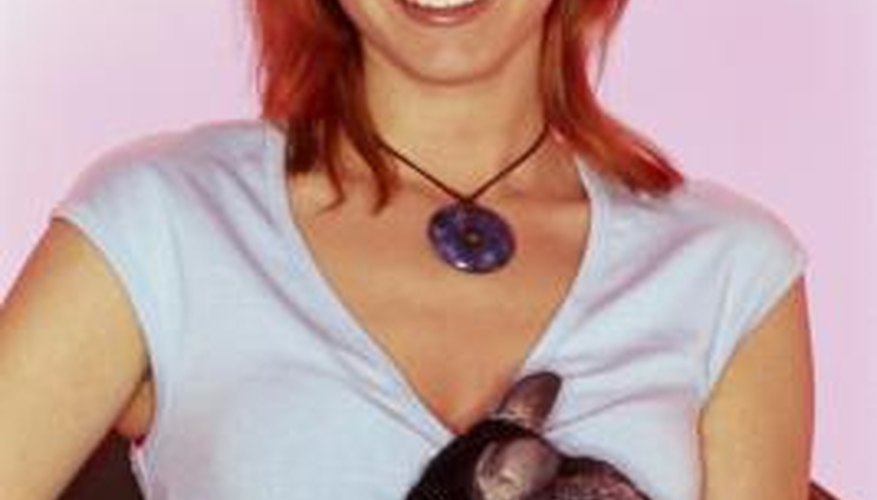Chinchillas are fun, interesting pets that bond with their owners and enjoy their owner's company. If they are healthy and their cage is kept clean, they are generally almost odour-free and easily tamed. Problems can arise if your chinchilla decides that one or more of its wood shelves should be used as a bathroom. All chinchillas need their shelves as they are climbers and jumpers, so removing the shelves is not an option. In fact, if there are not enough shelves for the chinchilla to climb and jump on, behaviour or health problems could worsen.
Clean the cage thoroughly using a solution of plain vinegar and water or a commercial enzyme cleaner with no other additives. Remove every bit of the old bedding, but set aside a small bit of urine-soaked bedding for retraining. Thoroughly dry every part of the cage after cleaning, before you put your chinchilla back in the cage.
- Chinchillas are fun, interesting pets that bond with their owners and enjoy their owner's company.
- Thoroughly dry every part of the cage after cleaning, before you put your chinchilla back in the cage.
Move the chinchilla's enclosure. Environmental factors may be frightening your chin, causing it to mark its territory because other chins or animals are too close, or because it feels insecure in its surroundings. Too much noise, either in the room or outside, can cause stress in your chinchilla. If moving the chin is not possible or doesn't help, consider installing noise-blocking curtains, a privacy screen or other mechanical means of making the area cosier for your nervous chin.
- Move the chinchilla's enclosure.
- Too much noise, either in the room or outside, can cause stress in your chinchilla.
Place a litter pan on the shelf that your chinchilla has been urinating on. This should not be plastic, as the chin will likely chew on it and may get sick from ingesting bits of plastic. A glass baking dish can be a very good, easy-to-clean litter pan. The pan must be attached to the shelf securely so it doesn't fall off. You can secure it by attaching thin blocks of wood or railings and setting the dish inside, or by encircling the dish with heavy wire and attaching that to the cage walls.
Fill the litter pan with either recycled newspaper pulp or pellet type litter. Both are available at pet stores. According to Dr. Dan Johnson of Avian & Exotic Animal Care in Raleigh, N.C., these are both safe options and won't harm your chinchilla if it chews these types of litter. However, if your chin eats large amounts of litter, this may indicate a health or diet problem and Dr. Johnson recommends getting a check-up with a veterinarian. Cat litter can make your chin sick and so can the oils in some wood shavings, so don't use these materials without the approval of a veterinarian.
- Fill the litter pan with either recycled newspaper pulp or pellet type litter.
- Cat litter can make your chin sick and so can the oils in some wood shavings, so don't use these materials without the approval of a veterinarian.
Place a fleece pad in the cage instead of a litter dish, if you wish. This will have to be changed very frequently and laundered between use. Do not use perfumed detergent to wash the fleece; wash it in the washing machine with enzyme cleaner or vinegar. The pad must be attached securely to the shelf using hook-and-loop closures or straps that attach to the cage wires. You could also attach hook-and-loop closures to the shelf and to the bottom of the fleece pad to secure it to the shelf.
Add the urine-soaked bedding that you set aside in Step 1 to the new litter dish or fleece. The chin should be attracted to its scent, which will encourage it to urinate in the new area.
Clean the litter area scrupulously on a daily basis. If the area is dirty or wet, your chin can get sick and also may find another place to urinate. Always leave a small bit of urine-soaked bedding in the litter area as a reminder for your chinchilla.
Clean up any accidents immediately, using the vinegar solution or the enzyme cleaner. Before applying the cleaner, soak a small piece of bedding in the urine and place it into the appropriate litter area.
- Add the urine-soaked bedding that you set aside in Step 1 to the new litter dish or fleece.
- Before applying the cleaner, soak a small piece of bedding in the urine and place it into the appropriate litter area.
TIP
If the wood shelf is badly damaged by urine, it is best to replace the shelf. Use only kiln-dried pine or other woods that are safe for your chinchilla to chew.
WARNING
Dr. Johnson says that, "While urinating on the shelf may be strictly behavioural, a bladder infection, bladder stones, and bladder tumours could also be responsible. Therefore, any sudden change in elimination behaviour should be investigated by a veterinarian."
